
There are two types of people that write link building guides.
Information marketers looking to sell courses or coaching and link builders who work in the trenches daily, developing link building strategies to secure valuable links for their clients.
If you are ready to learn from someone in the trenches, welcome to our complete guide to link building for SEO in 2023.
I am a firm believer in understanding “how” and “why” things work, so that a repeatable and scalable process can be built. While we will cover some specific tactics, this guide is meant to help you understand the process behind how we build links, so that you can adapt it for your own needs.
We will be starting with the basics and working towards advanced strategies, so feel free to skip around and jump into the section in line with your current experience level.

Under my direction, the Stellar SEO team has received multiple awards, and nominations, and has been recognized as one of the best link building firms in the U.S.
We work with, SMBs through enterprise-level companies, as well as other marketing agencies, giving us experience across many niches, promoting content of all shapes and sizes.
I have a great team that helps bring my vision to reality, and we have had the privilege of partnering with some brilliant in-house marketing teams, giving us valuable insight into our never ending quest to deliver Stellar link building services.
The information below has helped us build thousands of links for our clients over the past 8 years and if you take action on it, it can help you too.
Now that you know a little more about me and what to expect, let’s start with a look at the basics of link building.

Link building, sometimes called “link earning” is the process of obtaining a link to your website from a third-party website.
A clickable link on a third-party site pointing to your website will allow users (and Google) to find and visit your page. Links are also seen by Google as a “vote of confidence” for your website, but not all votes are created equal.
Some links have special directions associated with them that tell Google not to count the link as a vote. This type of link is called a “No Follow” link. Google has recently updated its stance to say that they take these directions as a hint, but may not follow them.
When those directions are not included, it is a “Do Follow” link, meaning it should be counted as a vote. That is of course a very basic explanation and some new attributes can also be added to links as well, such as:
rel=”sponsored’’ – this lets Google know the link is a paid advertisement (paid link), so they can treat it accordingly.
rel=”ugc” – this lets Google know the link is from user-generated content on your site such as forum threads or comments.
As you build links for your site, it is important to know which attributes are associated with your link, to understand how they can impact your site.
Not all links are created equal, nor are all methods of obtaining them.
We will explore the various types of links and link building tactics in more detail below, but first, let’s look at why they matter.
Links help your website show up higher in Google when people search for terms related to your business if your website is otherwise healthy. They can also give you instant exposure to the audience of the website linking to you, which can result in referral traffic and increased brand recognition, all while helping you rank better in search.
In total, there are over 200 factors that Google considers when determining how to rank your website. Some of these are believed to have a minor impact, while other factors are heavily weighted.
Inbound links (links pointing to your site from 3rd party sites) continuously land among the top 3 ranking factors, meaning they are a major component.
One study found that the #1 ranking website had 3.8X more backlinks than positions 2-10.
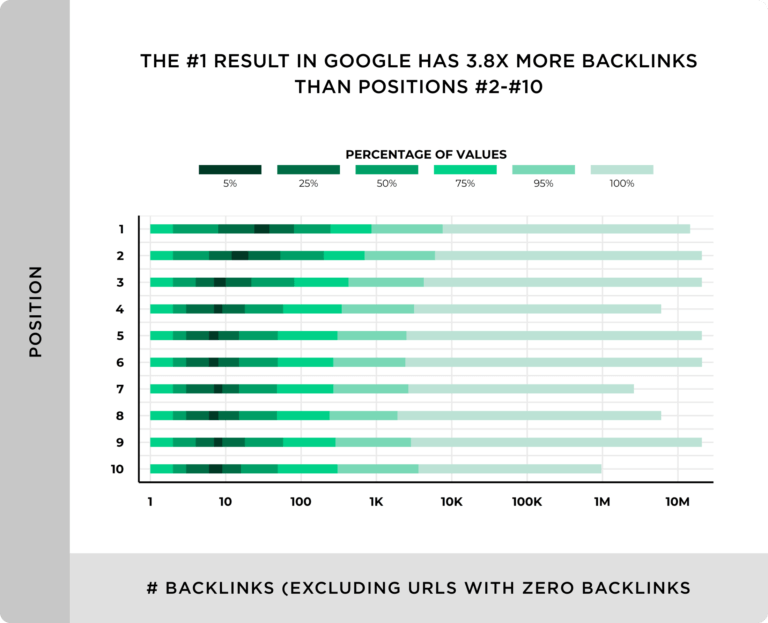
If you think about it, it makes a lot of sense. If two people wrote the same article – how would Google know who is right and who is wrong? Link building at its core is just a means of getting other people to endorse the information you are providing.
These endorsements help Google better understand whether or not your content is worth showing. This is also the same reason that not all links are created equal. Some can be seen as endorsements or “votes” while others are simply there because you created them yourself.
Beyond how the links came to be, the trustworthiness of the site linking to your site is also very important. If you are a Doctor, getting mentioned by Mayo Clinic is going to carry more weight than Bob’s Transmission and Fine China.
Earning good links is time-consuming and can be complicated, but that is exactly what makes them so valuable and important.
Getting the right links can catapult your site into the limelight while getting bad links can destroy your online presence. So, before you run off and start building links, let’s talk about what to avoid.
As you learn more below about research, planning, and executing a link building campaign, it will be easier to understand what works and what should be avoided.
For now, let’s look at some general tips that should help you steer clear of a link building disaster.
For the sake of fueling theoretical arguments, the SEO community loves to label things as white hat, black hat, or grey hat.
These terms are not a fixed definition, but rather open to interpretation. Some believe the only way to truly engage in white hat link building is to publish content and hope to get links.
On the other extreme, tactics like multi-tiered link building using link building programs like SeNuke or GSA Search Engine Ranker used to be commonplace.
Thankfully, link building has evolved considerably over the past several years, effectively rendering many such tactics useless.
As you go forward, I want you to think about links on a risk vs. reward scale, and forget about silly labels.
If you want to learn more about the history of link building, be sure to check out our post detailing the changes over the years.
Instead of listing every possible thing you should avoid, let’s direct our focus to what you should be looking for.
When you set out to build your links, you should be looking to be mentioned within the main content of a page/post, or on something like a curated resources page. Links in the main body of the page carry more weight than links in the footer or sidebars.
The website you reach out to should have useful content, it should be relevant to either your niche or your location (Geo-relevancy), and it should have a real purpose.
Look for things like social media profile links, a way to get in touch via email or phone, and don’t ignore your first impression. This will help you differentiate between a real website and one setup just to publish guest posts.
Taking these few steps can help you weed out a number of low quality sites. We will get into this in even more detail below. Link building is time and resource intensive, so you want to make sure your efforts aren’t being wasted.
But for now, let’s dive into research and planning.

One of my favorite quotes by Abraham Lincoln is: “give me six hours to chop down a tree and I will spend the first four sharpening the axe.”
While the excitement of getting mentions and links might make you want to jump ahead, don’t do it.
Taking the time to put together a data driven strategy will help you make the most of your efforts and investment into link building and content marketing.
So, let’s look at the fundamentals of conducting a competitor analysis, with a focus on competitor link analysis.
The first thing you must understand is how links impact a website.
When you build links to a website, those links impact both the page they are being built to and the site as a whole.
This means that when you are pulling together a plan to promote your pages, you must take both into consideration.
The total number of inbound links your competitor has to any page on their website will determine their site wide authority. This is often measured by Domain Authority or Domain Rating, two popular metrics that look to quantify the authority of a website as a whole.
When a website has a lot of sitewide authority, it often takes them fewer links to a specific landing page to rank. This is why some link building strategies focus on high DA or DR links, to any page on the site vs. a specific target page.
For example -if one site has a Domain Rating of 50 and the other site has a DR of 30, the higher rated site may only need 5 links to their landing page while the lower rated site needs 10 links to a landing page, to get the same outcome.
In order to determine if this is the case in your vertical, you must also look at page level link metrics.
In this context, a landing page simply means the page on your website that is best optimized for the keyword (s) you are conducting an analysis around.
Let’s say your keyword is “best guest posting services” and the number one site has a sitewide DR of 70, with 5 links pointing directly to their landing page for that term.
On the other hand, your website has a DR of 35. Since you have less sitewide authority, you are most likely going to need more links to your landing page to achieve similar rankings.
This is because sitewide authority is passed between pages through internal linking, giving them a head start over sites with little to no authority.
However, numbers alone won’t tell you the full picture.
On the page level, you also need to understand how your content compares to other ranking pages. This can include length, but also purpose and value. The quality and optimization of content can sometimes help to close the authority gap, which is why you may see sites ranking that are “weaker” than the other top ranking sites.
Now that you have an understanding of sitewide vs page level link metrics, let’s look at how to put that to work in your link building efforts.
Don’t worry, we will talk more about content in chapter 3, including understanding query intent and competitor content research.
When you think of competitors, there are probably a few businesses that come to mind right away. However, when it comes to SEO and link building, those aren’t your only competitors.
Any website that occupies first page space for the terms associated with your products or services becomes a competitor when putting together a link building plan. Even if they offer a different solution to the same problem.
This means the first step in your link building plan should be to identify the most important keywords for your business. These are not the only keywords you will be working on, but rather the MAIN terms that will turn up the competitors who are seeing success from their content and link building efforts.
We are not going to cover keyword research in detail here, but here are a few good resources to learn about keyword research.
Once you get into the actual link building, all of the keywords associated with your website content can benefit from the links, so don’t think of this as an exercise in advanced keyword research, but rather a seed list of terms to turn up strong, relevant competitors.
With this list in hand, head over to Google and make a list of the top 10 sites ranking for each of your main keywords.
If you use a tool like Ahrefs, you could also use the keyword explorer to gather the same information.
The tool is a better option as it will save you time on the next step, which will be to log the sitewide and page level link information about your competitors.
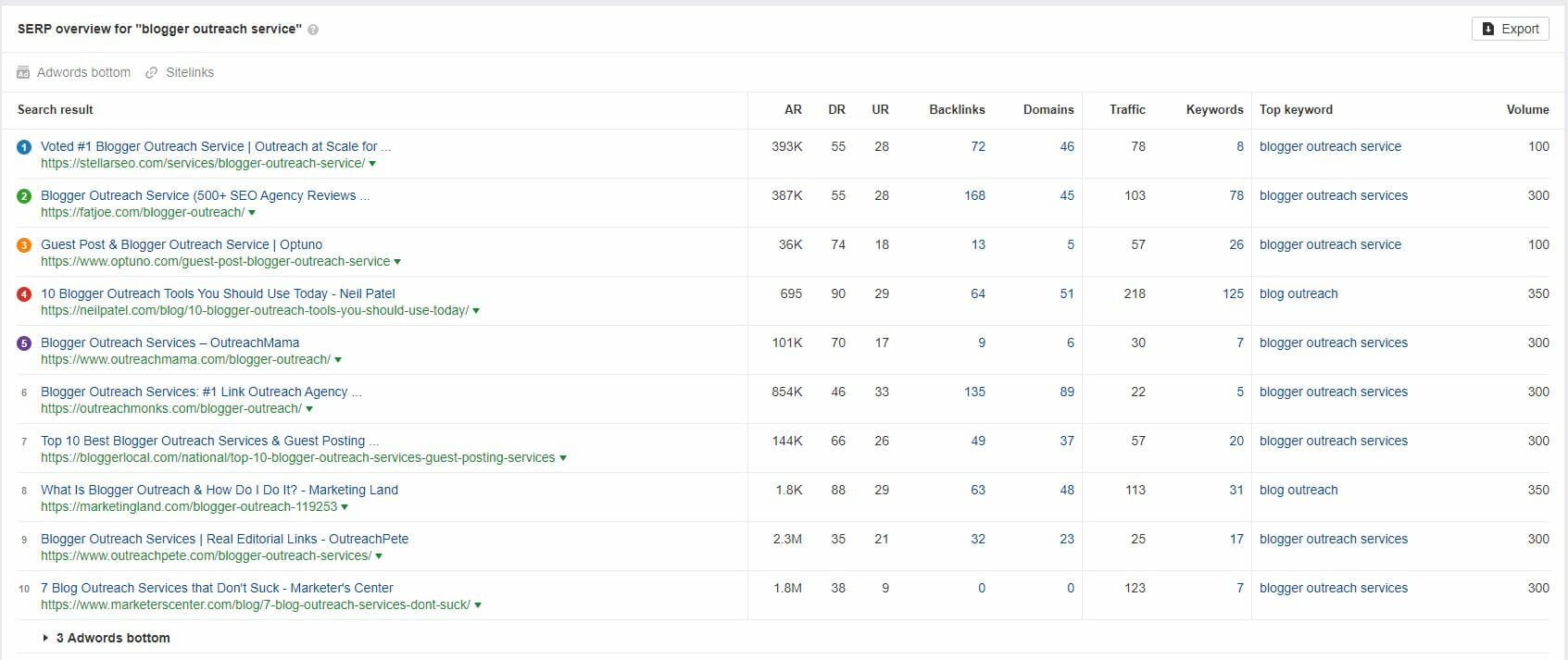
In either event, just repeat this and add the EXACT ranking URLs to your spreadsheet until you have gone through all of your main keywords.
Here is a Google sheet you can copy and use to log your information. The metrics in the sheet are from Ahrefs, but you can replace them with metrics like DA from Moz if you prefer, just be sure to use the same tool to gather data for each site to enable an accurate comparison.
Competitor Link Building Data Sheet Template: Click Here to Open It
The sheet linked above will allow you to log the sitewide authority, traffic, keywords, and indexed pages.
In chapter 4 we will dive into page level metrics, reviewing, and sorting your competitor links, but for now our focus is on high level averages.
Once you pull that information together, add your website stats into the list for each keyword set.
This will allow you to see how your site compares to the competition for each of the main terms, at a high level.
For each of the main terms, calculate the average of each metric, and see where you fall below that average.
For example – in the sheet, with the fictional data for “dog walking nanny”, our site has:
This would mean our general sitewide plan to be more competitive for “dog walking nanny” would include:
When we get into page level planning below, we will cover what to look for there as well.
Now, since you have repeated this for multiple keywords, you will need to repeat the steps above until you have a log of all the averages.
At that point, you can create a secondary data set, which is the combined averages for all the sites on your competitor list. This will give you a sitewide target.
For example – if across all the main keywords, the sitewide average is the same as in our example above, you now have a specific, sitewide goal target.
Using our example data it would be to:
Notice our goal is not to increase Domain Rating or Domain Authority. That is a secondary outcome of acquiring new, quality links and DR/DA does not directly correlate to rankings or organic traffic.
In chapter 5, we are also going to look at link distribution between pages, which will help us systematically determine where to build the new links for the best results. Additionally, we will look at how to vet link opportunities, as not all links are created equal.
Sticking to our high level analysis first, let’s look at part two of building a strategy – velocity.
Link velocity simply refers to the speed at which new links are built (or naturally acquired) to a website or individual web page.
In the past, automated link building tools made it possible to build thousands of links per day, which is when this first became a topic of discussion among link builders.
Since the types of links you should be building today require manual outreach, content development, and approval by someone at the site you are working with, this is less of an issue.
Even so, it is possible to buy links from a service in unnatural amounts, causing your site to lose rankings or even land an unnatural links penalty.
For this reason, it is important to use common sense when launching a link building campaign.
Here are a few practical examples.
Example 1 – you have launched a new affiliate website, with 10 articles published and you do not have a PR campaign in place.
Example 2 – you launch a website for a new product from a major brand, that is concurrently running a PR campaign to gain media coverage about this new product.
We have run campaigns in both scenarios and our approach changes to match the circumstance.
In example two, the association with the large brand parent company, paired with the additional signals created by the PR coverage (and other types of advertising as well) allowed us to start at a much faster pace and aggressively ramp up their link building timeline.
In example one, the limited content and singular marketing approach required us to start slowly and increase the pace over time, to create a gradual and natural link growth curve. For a brand new site, we have started with as few as 3-5 links in the first month, with a subtle month over month increase for the first 6 months.
Aside from thinking logically, you can (and should) also look at typical link growth within your space.
This is easy to do using Ahrefs or a similar tool, by simply looking at the referring domain history of your competitors.
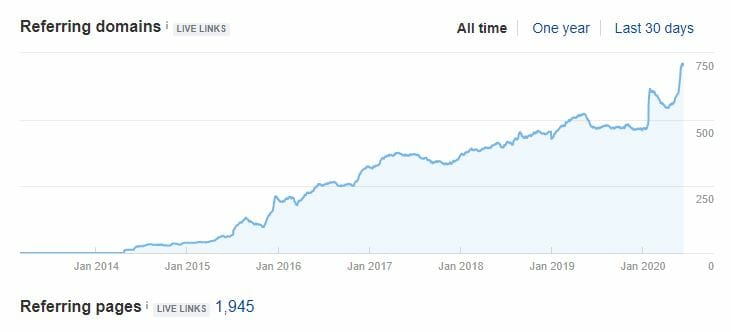
On the sheet we shared above, just make some notes about what you are seeing when you look at competitor link growth over the past 12 months.
After doing this enough times, you will notice that certain types of keywords (informational vs transactional) and different niches experience link growth at different rates.
Taking the time to research and understand this will help you determine how quickly you can build links without “breaking out” of those averages.
If you go over, that doesn’t mean you will instantly get penalized, just think of this as good “rule of thumb” planning data.
Combining the data with your understanding of the full picture (such as the two examples above) will help you decide where you should fall with regards to pace.
By completing the steps outlined above, you now have a lot of great information about the competitive landscape and how your website compares.
The next step is to put this into a preliminary plan, as we discussed in the above examples. This doesn’t have to be overly complex, as you still have more research to do, but this is a great time to put your findings into writing.
Here is a quick example, using the fictional data from above.
Currently our website falls below the competitor averages for:
In order to improve our standings in the competitive landscape, we need to take the following actions over the next 12 month period:
Once you have your rough outline of what you need to accomplish, it is time to refine that plan with specific action steps, starting with a closer look at your content.

Since content is the foundation of every website in existence, we are going to look at how to find content ideas and how to optimize your content based upon competitive research.
If you don’t have quality content on your website that covers your targeted topics, you aren’t going to rank for them.
If your content isn’t on par with (or better than) your competition, you are going to have a hard time ranking. I don’t just mean quality, but also how well optimized your content is for users and search engines alike.
Quality content is obviously an important part of earning links, but more so, it is the very reason you need links in the first place.
Let’s look at how to plan and optimize your website’s content.
Ahrefs, is one of our preferred link building tools, which is why we are referencing it specifically. There are other tools that you can use in place of Ahrefs to complete the same tasks, so focus on the process not the tool.
One of the most effective places to start your search for content ideas is through competitive analysis. We like to do this using “Top Pages” from Ahrefs.
Another popular tool for this is the “content gap” analysis, which shows you keywords that one of more of your competitors is ranking for that you are not.
Top pages show you the pages on your competitors site with the most keywords and highest estimated % of traffic.
We prefer top pages since it allows us to find topics and to verify that they have traffic potential all in one step.
Content gap analysis is great to find specific keywords that you are not ranking for, but those terms are not necessarily going to be a great source of traffic.
When you focus on a broader topic, it opens the door to hundreds if not thousands of potential keywords to rank in a single article, making it a great source of website traffic.
In order to use top pages, all you need to do is enter the website address of your top competitors (or those you found using the steps above) and you can view their top pages.
Here is an example:

As you can see, the most popular page on socialmediaexplorer.com accounts for about 14% of their total estimated monthly organic traffic, making this a good topic to target if you were in the same space.
It also provides you with the top keyword for each page, along with the list of other keywords ranking in the top 100 if you click the down arrow under the “keywords” heading. On the link building side, you can see the number of referring domains built to each URL, which will give you an indication of difficulty or popularity of a topic.
Remember, a low number of RDs does not mean low competition as the site ranking could be doing so from strong sitewide authority.
When it comes to compiling data, having a larger set of information helps to prove a concept. If you were to take your full list of competitor sites from the earlier steps and make a list of their top 10 pages, you would likely end up with a lot of great topic ideas.
Here is a template you can use to record your competitor’s top pages.
Competitor Top Pages Link Building Template: Click Here to Open It
We have filled in some example data using socialmediaexplorer.com and kicksta.co.
If you look at the template, you will see that the top page for Social Media Explorer is about “Instagram follow bots”.
If you move down to the top page for Kicksta.co, you will see that their top page is also about “Instagram followers”.
That gives us a pretty good indication that a long form content piece talking about how to build up Instagram followers, which a sub-section talking about Instagram follow bots is likely to be a good source of traffic, once ranking.
You can also see that between just those two URLS, there are 150 websites linking to them. If you were to complete the sheet for the rest of your competitors, you would gain even more insight into both topics and supporting keywords, along with an idea of where to start your outreach once your piece is completed.
We will get more into the outreach portion in chapter 4.
This is just one way to find topics, but it has worked for us very well.
What you have to keep in mind when making a plan is that imperfect action beats inaction every time, when it comes to producing content. As you become more experienced, the methods and level of research can also increase to match.
Either way, once you have some ideas for content topics to cover, the next thing you must determine is the purpose of that content.
When it comes to producing content, two important considerations are:
Likewise, when it comes to determining goals and purpose, there are also two important considerations:
In order to create content that can rank well and perform well with your audience, you must find where searcher intent and your goals overlap.
First we are going to look at some common goals of content, then we will touch on how to determine searcher intent so that you can match the two accordingly.
When it comes to content goals, most content is created to serve one of the following 4 purposes:
Different types of content are typically associated with each purpose, here is a good visual representation of that.
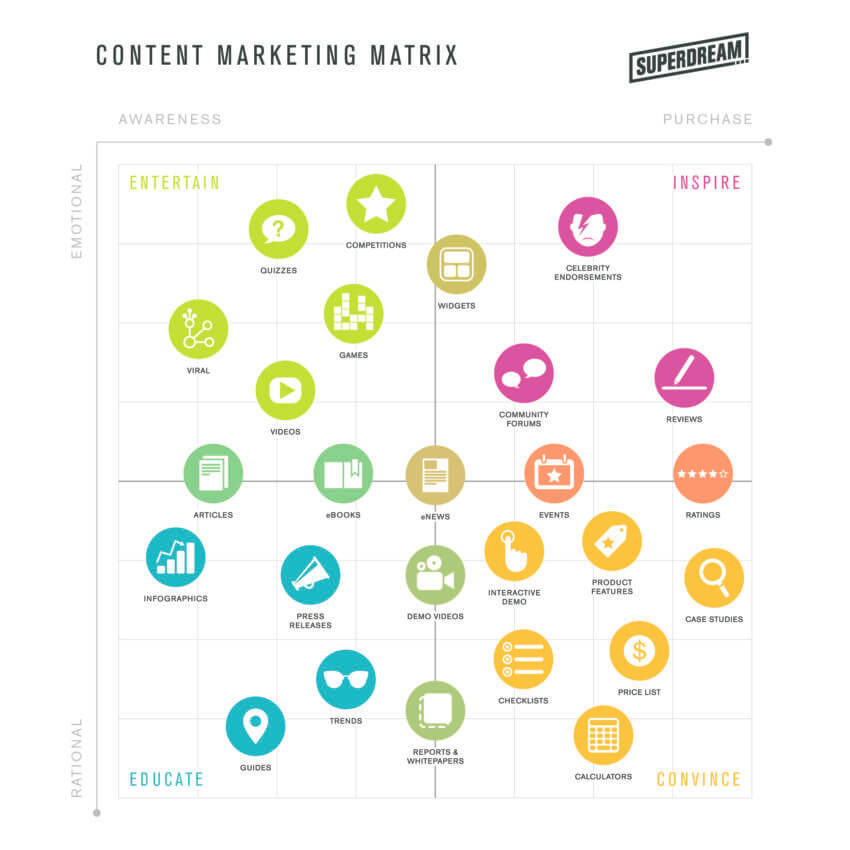
Source: https://superdream.com/news-blog/four-main-purposes-of-content
The good news is, that even if you are not a content marketer by trade, it is still pretty easy to determine the purpose of content.
Once you know the purpose, it is easier to avoid one common but critical content mistake. Not properly aligning the goals (or call to action) of your content with the current stage of the reader in the buyer’s cycle.
Just keep reading and by the end of this section you will know exactly how avoid making this mistake in your content!
Above, we talked about the top page from Social Media Explorer and Kicksta, which centered around getting Instagram followers.
If we look at those two articles (click here and here to open them), the purpose of both pieces is pretty obvious. They are written to educate, otherwise called informational content.
If you were to head over to Google and complete a search for “Instagram followers”, you will notice that more than half of the first page results are “how to” articles. This gives you a pretty good idea of the intent of the searcher, which in this case is most likely to be educated on the topic.
This is just one of the four main types of search intent.
Search engine traffic is so valuable because Google does a great job of surfacing content that aligns with the underlying reason a search was completed.
Searcher intent can be defined as the “why” behind their search. Most searches completed fall into one of four main types of searcher intent which are:
An informational search is one completed with the goal of learning new information, such as in our example above using “Instagram followers” or any type of search using modifiers like: who, what, when, where, why, or how to. A how to search also often includes terms like guide, tutorial, tips, and resources.
Transactional searches are done by someone looking to make a purchase. This could be a search like “buy 20lb dumbbells” or “Luke Combs tickets”. Transactional searches will often include modifiers like: buy, coupon, pricing, order, on sale, and free shipping.
Navigational searches are those done in place of typing in a website address directly. For example, if you searched for something like “Facebook login” or “Netflix” to reach the site. A navigational search almost always includes the name of a business, product, or service. If a company has a well known tagline or jingle, that could also be used in place of the company name to navigate to their site.
While this type of search is most commonly called investigative, I prefer to call it comparison searches. This type of search is done by someone who is looking to compare more than one service. What makes this interesting is that most comparison searches are also informational, although the information they are seeking is usually related to specific features and pricing.
Investigative searches typically occur near the bottom of the funnel, just before a searcher moves to make a purchase, making this especially valuable to marketers.
Once you have an idea of the purpose of your content and the most likely intent of the person searching, it becomes much easier to work in your desired action, which is usually some form of conversion.
A conversion can be any action that you deem valuable. A purchase is a conversion, but so is getting people to sign up for your email list or to download a white paper.
When you are planning your content, understanding which stage in the buyer cycle the searcher is most likely in will help you create additional content or assets to capture or nurture that visitor.
For example – If someone does an informational search such as “how to get more Instagram followers” and finds a guide on your website, they are best suited to receive top of funnel content.
In this case, if you made a downloadable checklist or templates they could use to increase their Instagram followers, the likelihood of them downloading your content (a conversion) asset is higher than if you went straight to selling them a “done for you” service.
If on the other hand someone completed a search for “best Instagram follower services” and you offered them a DIY checklist, they are less likely to convert.
Properly pairing your conversion goals (desired action from the content) to the searcher’s intent and content purpose is one of the best ways to skyrocket your conversion rates, so make sure you take the time to get it right.
It is also important not to lose sight of the big picture, which is to produce content that can rank well in Google, so that you can get qualified viewers to your content and calls to action.
As such, it is important to look at one more element before finalizing your content – what are your competitors up to?
There is no shortage of content on the internet, much of which is below average. However, a select group of people in every niche and industry go above and beyond to create awesome content.
Of this group an even smaller number go on to rank in the top few spots for the most competitive terms their content is targeting. These are the people we want to analyze and outperform.
In chapter 4 we will get into the link analysis portion, but before we do that, we must make sure our content is on point.
To make it less subjective, we have put together a simple template that you can fill in when looking at the content that is currently ranking in your space.
Competitor Content Averages Template: Click Here to Open It
We have filled in the data from our example article above on Kicksta.co, as you can see on the template. Using the information discussed above, we know that the intent of the searcher in this case is informational and the purpose of the content is to educate, which is the correct match.
Using the free tool wordcounter.net, you can easily copy and paste the page content to get a lot of information, including the word count, which is about 5,500 words in this case.
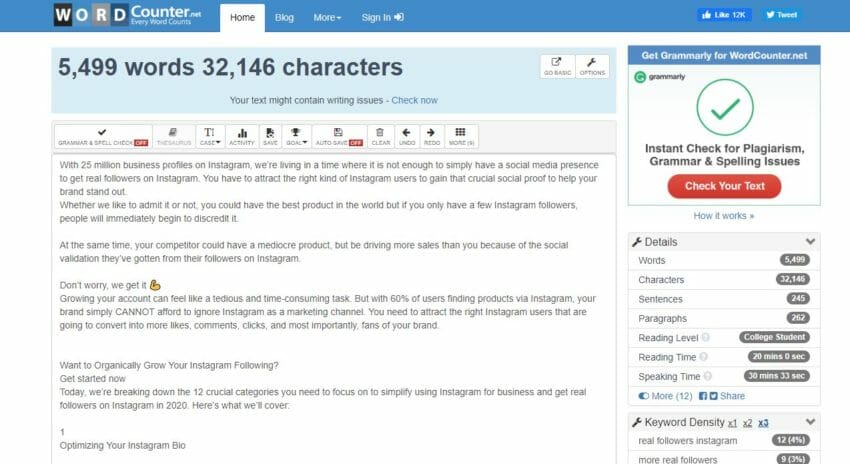
The number of referring domains (RD) was recorded when we exported “top pages”. The other checks require you to simply open the page and make note of what you see. In this case, the content was current and overall looks to be a good quality piece on the topic.
If you were going to create a piece to compete with this, conducting deep research to uncover new data, leveraging video content, and interviewing experts for added insights would be some basic actions I would suggest.
In many cases, you will find that the content ranking isn’t nearly as good. The purpose of this exercise is to help you objectively rate content and determine averages, such as word count, so that your content meets or exceeds what is currently ranking.
You may find number 1 & 2 are exceptional, but the articles ranking in positions 3 & 4 are lacking, so don’t be discouraged when there are a few great pieces of content that are going to be hard to top, just look for your spot among them.
Now you know the basics of creating purpose driven content and matching it with the intent of the searcher.
We have also outlined how to size up your competition when it comes to creating the plan for your new content pieces.
The process we covered here can be repeated for every piece of content you create and this process can be scaled across your full content team, allowing you to produce content at scale that can rank and convert, once you acquire quality inbound links to it.
So, let’s take a look at how to find and screen link opportunities, so that you can promote your content.

Regardless of niche, there are plenty of great link opportunities, if you know where to look. Our favorite place to start is by reviewing competitor links.
In order to make the most of competitor link analysis, you must be able to distinguish the good links from the bad accurately. You must be able to group them by outreach tactic, which will ensure you send the right pitch, increasing your likelihood of securing a link placement.
We are going to take a look at some common tactics and then dive into building your outreach list by pulling your competitors links.
When it comes to link building, there is no shortage of tactics.
Here are some link building tactics in use today:
Those are just a few, I have seen lists with over 100 tactics listed. The good news is, this list can be simplified into a few groups.
Names aside, if you can identify how a link was most likely placed, you can adjust your link building tactics to increase your likelihood of success.
Let’s look at a few examples.
Resource pages can come in many forms, but the most typical is something like this page:
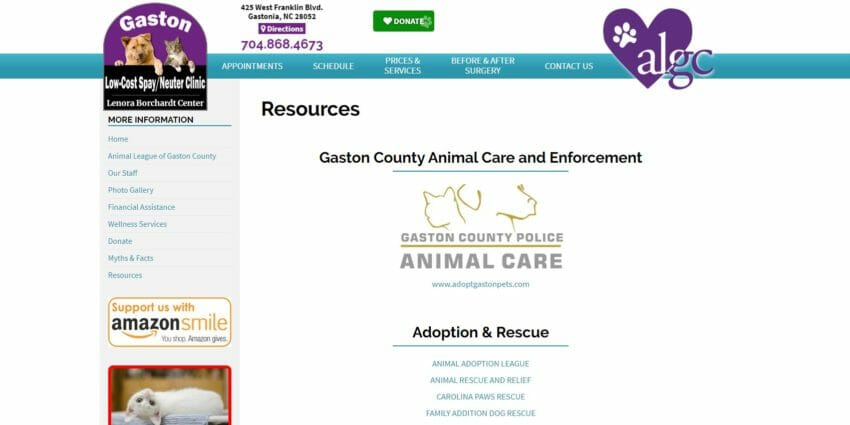
If you open the link above, you can see that it is clearly labeled as a resource page and they list links to various websites related to pets.
If you have a pet resource on your site, this would be a good example of a page to reach out to about getting your link added (resource link building).
Guest posts are pretty easy to spot, as they often have an author bio. Here is an example of a guest post I contributed to Website Magazine, on link building strategies.
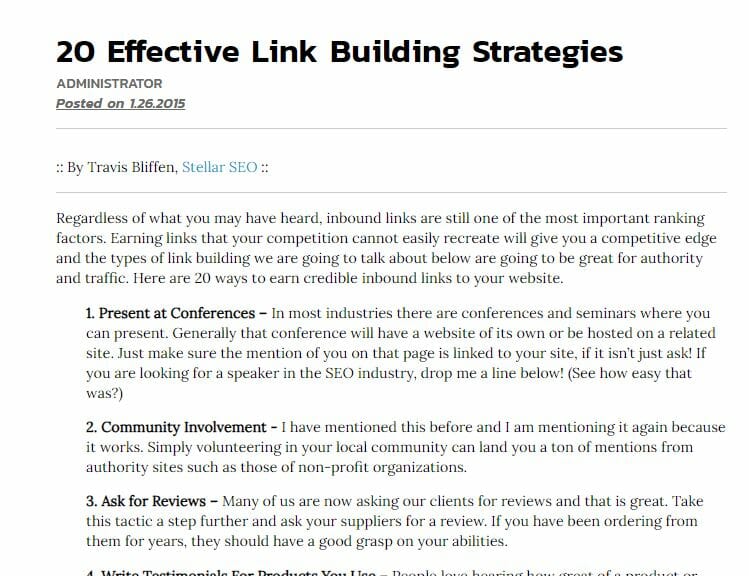
If you open the link and scroll down to the bottom, you will see an author bio. This lets you know it is a guest post.
Links placed through “blogger outreach” may have an author bio listed from a website staff member, or may not have one at all. This means you have to instead look for signs that they would accept contributed content.
Usually you can find a link in the footer or menu somewhere with text such as:
The wording will vary, but if you suspect it is a contributed piece of content, start by looking for a link to an information page. If you do not see one on the menu, you can try a simple search operator to view their indexed pages for certain keywords.
Here it is, using the example site websitemagazine.com
Site:websitemagazine.com + “write for us”
The “site:” followed by the URL tells Google to show pages in their index for that website as a whole. The keyword “write for us” (which can be swapped out for other related terms as well) asks them to show indexed content containing that keyword.
Many times, if a site accepts content, using the two methods above will help you find out what you need to do next.
Even if you don’t see any indication that a site does accept content, it never hurts to reach out anyway. This is how some of the best link building opportunities come to light.
Both a link roundup and an expert roundup work under the same premise. You mention people or curate content from others in the hopes that they will mention your article in return.
For this to work, it is a good idea to curate information from brands/people who have a larger audience than you do, so that you can get added exposure.
In some cases, a link roundup is actually more of a curated resources list, so you may see a bit of overlap between this and resource pages.
Here is an example of an expert roundup:

Here is an example of a link roundup:
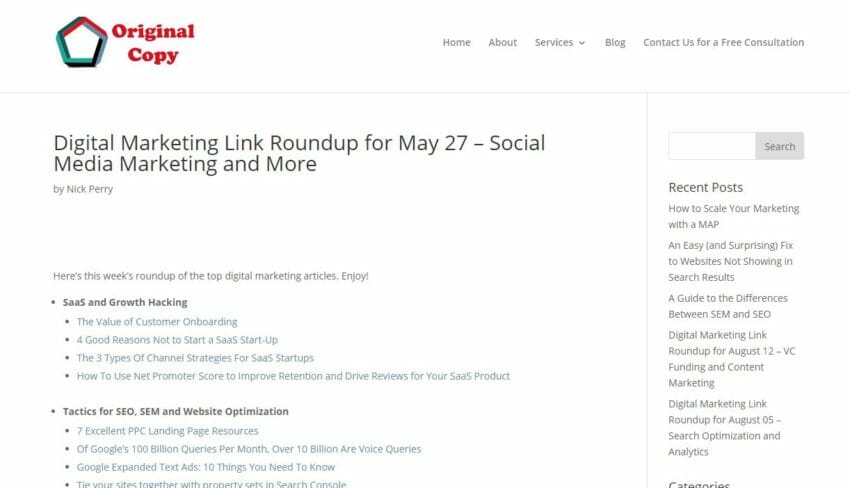
It isn’t possible within the confines of this post to define every single link building tactic, but if you check the resources in chapter 7, you will find plenty of opportunities to learn more about various tactics.
One thing to keep in mind as you get started is that you are reaching out to other people.
If you are not sure exactly how a link came to be, reach out to and let them know you are interested in contributing. In many cases, they will let you know what to do next. If you are reaching out to a large site, make sure you take the time to find the best contact for the section you are reaching out about or you are most likely going to be ignored.
But, before any of that, you must make a list of sites that you are interested in contacting. Let’s look at how to build that list.
In the early steps, you created a list of competitor websites, and also the top pages on their websites. This is where your link prospecting should begin, starting with the page level referring domains.
If you already have the content on your site to promote for a set or terms, it is time to start pulling links. If not, take a step back to the content portion and complete your research to prepare an article, then come back.
Going back to our earlier example of https://kicksta.co/how-to-get-real-followers-for-instagram for the keyword “instagram followers”, let’s start by seeing who links to that specific page, by using Ahrefs referring domains.
To do this, simply enter the URL and select “exact url” on the overview page.
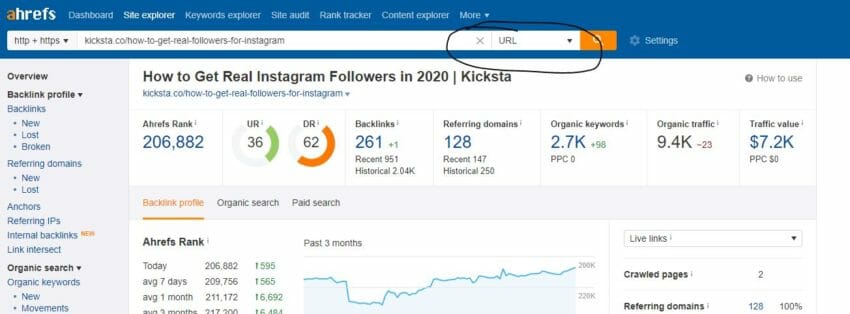
From that page, you just click the blue number under backlinks to open the list of inbound links to that specific page on their website, making sure to select “URL” and to avoid seeing multiple links per site, click “one per domain”.
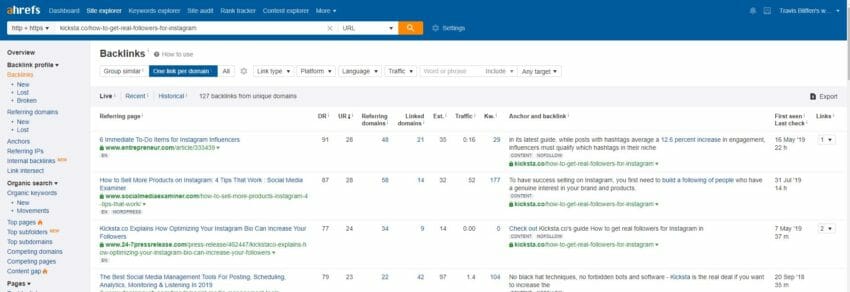
From, there you can hit export, and add the data here:
Competitor Links to Landing Page: Click Here to Open It
You will need to delete a few columns before adding it into the template or you can add those back if you plan to use them. We prefer neat and simple on this.
Once you have added the information for the first competitor, just repeat the process until you get through all the competitors listed for your particular page, which in this case would be the other “Instagram followers” URLs you recorded earlier.
Once you have a list of potential sites, you need to screen them and sort them into groups.
In chapter one, we touched on link attributes such as “no follow”, as well as the fact that not all links are created equal. Now is the time to circle back to that and separate the good from the bad.
This is also when you have to stop and consider what you expect from the link.
We are going to cover the basics of site screening below.
If you had the ability to guest post on a high traffic, authoritative site in your niche, but the link was going to be no follow – would you do it?
If you are looking for increased recognition or referral traffic, this would be a great time to put in effort for a no-follow link.
The same is true for sponsored links, using that attribute. The SEO value will be minimal, but if you can gain brand recognition or good referral traffic, it still makes it worthwhile to consider.
Now, if you are looking for links to boost your rankings, “do follow” links without a sponsored or UGC link attribute are going to work better for you.
Before you go any further – make sure you stop and think about what you are hoping to get from your link building. You could have a singular goal such as improved rankings or you could be looking for all three.
This is something you (or your link building agency) needs to know, to ensure the link building tactics selected match your campaign goals. Niche edits for example are a great way to improve organic rankings, but not such a great way to build brand awareness.
Once you are clear on what you expect, it is time to move onto finding sites that can meet those expectations, starting with a look at quality and relevancy.
When reviewing a website to potentially acquire a link from, there are two main types of checks to be made:
With both types of checks, you must think of these checks as a process, not a pass or fail exercise.
In some industries, all the sites you encounter will have lower quality and standards. This is true for local websites especially. Even though they are not impressive in terms of metrics, those sites can be great for local link building.
You also must take into account your skill level, budget, and resources. If you are a local business, it probably wouldn’t make sense to commission a $250K study to turn up new statistics in your field for the purpose of creating a linkable asset. However, there are plenty of industries in which that would pay off tenfold.
As you look at more and more sites in your niche, you will get a feel for how sites stack up, making it easier to determine if a site is above or below average.
You can also set some minimum metrics to help save some time in reviewing sites. These can vary, especially when it comes to local link building, but here are some general ones we use for our organic link building:
For a local link building campaign, the organic traffic can be much lower, due to the nature of location-based keywords. We have seen sites with traffic estimates of 50-100 that turned out to be great local links, so keep that in mind.
Once you run through this process and get a better feel of your space, it is time to move on to creating your shortlist.
Through the earlier steps you should have a long list of potential sites that you can contact for links
Once you set your standards for the links you want to attempt to recreate, it is now time to get brutal with eliminations.
First, if you are using metrics to filter out sites, delete any sites that fall below the standards you have set.
After that, look for sites with recent traffic drops, using Ahrefs “organic search” tab.
Here is an example of a site that saw a traffic drop from 245K to to 116K month visitors, indicating a potential issue. This would result in us removing this site from the list to contact.
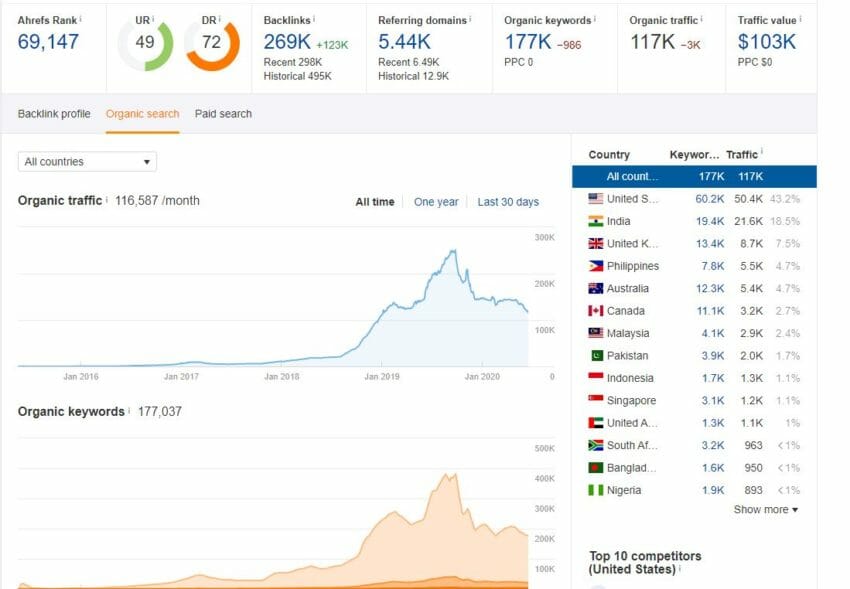
The total traffic isn’t the issue on this as much as the trend. Here is an example of a lower traffic site that is trending in the right direction:
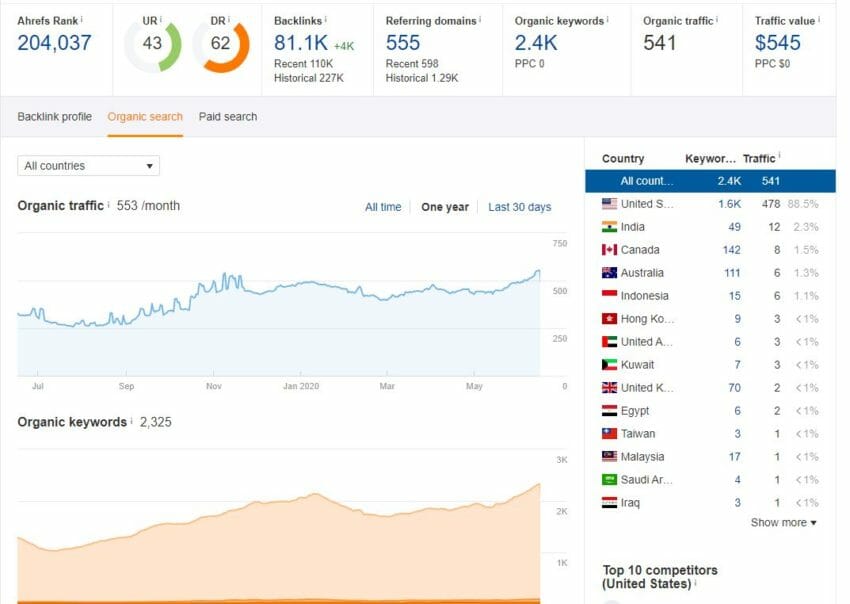
The important thing to keep in mind is that all sites will see some level of fluctuation. What you are looking for is confirmation that over the past 12 months (or longer) their site is steadily improving.
You also have to take a more holistic view of the situation. Link building is relative to your competition (niche, location), as stated above, meaning your metrics should slide one way or the other to match the standards of the niche you are working in.
From the example above, I can already hear the faint droning of internet trolls (pictured below) typing feverishly about the fact that I told you to skip a site with organic traffic of 150K (ish) per month and use one with an estimate of 555 (ish) monthly organic traffic.
However…
In this case, the low traffic site is both niche relevant and Geo-relevant to the site we wanted a link to. It is just a local business, with a lot of low volume keywords.
The high traffic site is a general site, and aside from traffic, the quality of their content is also slipping heavily over the past few months.
While you can put baselines in place, link building isn’t cut and dry and no single set of metrics can tell the full picture, which is exactly why we focus on process, not a fixed list of tactics or metrics.
Anyway, back to it. Let’s look at how to screen sites for relevancy.
For the ones remaining, it is time to switch over to your subjective checks, starting with relevancy. If the site is completely off topic, take it off the list.
For the others, you are likely to find varying degrees of relevance. Some will have relevant content on a general site, some will be Geo-relevant, but not topically relevant (good for local SEO), and the best ones will be on a relevant site, in a relevant article.
As you go through the link profiles of your competitors, you will likely notice a combination of these. In your tracking template, it is a good idea to make note of how relevant you perceived the link to be, so that you can prioritize those when outreach begins.
Now that your list is definitely much shorter than when you started, it is time to open up each site remaining so that you can size it up.
The first thing we like to look for is sidebar and footer links to spammy topics such as:
If they have links to those items, we get rid of them, unless we were looking for links to those topics of course.
After that, we take a look at the site ‘s purpose. Earning money from ads or affiliate product promotions, promoting a product or service, or to discuss a hobby are all examples of why a site may exist.
The important part of this is to rule out the site’s only purpose being to post low quality guest posts. You can learn a lot more about this in the Google Quality Raters Guidelines PDF, so I suggest taking some time to read through that before you start screening and eliminating sites.
Once you have a good grasp of site screening based upon purpose and quality, it is time to finalize your link building strategy.

This is it, time to pull everything together into a plan and put it to work, starting with a page level breakdown. Getting your link building strategy right is extremely important, so take the time to do thorough research and planning. I have personally seen countless examples of great links not backed by a sound strategy lead to wasted time and resources.
Earlier we discussed how links can impact the page they are pointing to and the website as a whole. Just as you did earlier on the sitewide level, you need to come up with some averages to guide your plan and record that data.
Page Level Link Breakdown Template: Click Here to Open It
To make it simple, we are going to look at an example of this using the keyword “Instagram followers” from above.
The first thing you need to figure out is the average number of referring domains to the landing pages ranking in the top 10.
You can use the Ahrefs Keyword Explorer to view the necessary data in one spot.
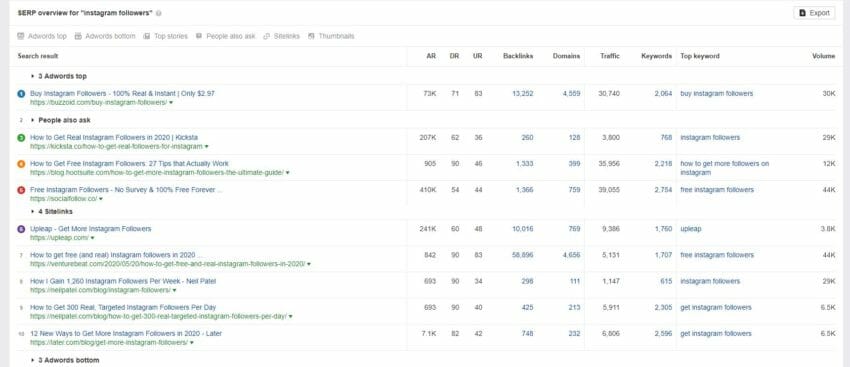
To find the average referring domains to the landing pages, you simply divide the total number of referring domains by the number of sites, which is usually 10.
However, if you notice a site that falls way outside of the typical range, it is best to exclude it. In this case, I would exclude the #1 site as it has 4559 RDs and #7 as it has 4656, which are both outside of the normal range. Numbers 5 and 6 are also quite a bit above, so we will omit them as well.
That would leave us 5 sites, so take the total number of each of those under “domains” and add them together, totaling – 1083. Divide this by 5 and you have an average of 216.6 referring domains for the ranking “Instagram followers” page. This goes into column “b” on the template.
Using those 5 sites, you will repeat the process to find the average domain rating, which is 82.8. This goes into column “c”.
Now, let’s find an example landing page not in the top 10 to use as “our page” in this example. We will use: https://sproutsocial.com/insights/how-to-get-followers-on-instagram/ .
The sitewide authority of their site is 88, which is above the average of the top ranking sites. The number of links directly to their landing page is only 96, which is below the average of the ranking sites.
This gives us realistic expectations of what it could take to rank. Remember, not all links are created equal, so this isn’t just about the numbers.
For the sake of argument, let’s assume all 216.6 links (the average) are good quality, as are the 96 current links to the Sprout Social landing page.
This information tells us how many links we may have to acquire to rank, which can be used in planning the overall cost and timeline for a project. This data can also help you pinpoint other issues with your site or content.
If for example you went out and acquired 120 quality links and your page didn’t move at all, this should be an indicator to first review the page itself, then your site and link profile as a whole.
Without a number in mind, you may have continued building links, even after it became apparent that wasn’t the only issue at hand.
These are just estimates to help you narrow in on a target and timeline, but when used as part of the “big picture”, this data can be insanely valuable.
Along the same lines, your anchor text plan should also be data-driven.
Anchor text is the word (s) you click to open a link. Anchor texts fall into a few main categories:
Prior to 2012, the key to ranking well for a particular keyword was to get a lot of inbound links using that keyword as the anchor text. Once Google updated their algorithm, using exact match anchors too often became the best way to never rank for a term.
This means that building the correct anchor text profile is just as important as getting good links. The good news is, that if you are getting links from relevant, quality sites, you can rank very well using branded, naked URL, and page title anchor texts.
We covered this in more detail in our post: Natural Selection: Creating a Winning Anchor Text Profile , so we won’t rehash it all here, but here are a few key takeaways:
The most important takeaway here is that you need to have a plan for your anchor texts, to keep your site safe. If you do not want to get exact and determine specific percentages, using branded anchor texts is always a safe route to go, although it may not be the fastest.
If you are not familiar with anchor text planning, be sure to check out the related resources in chapter 7.
We have covered a TON of information up to this point, and hopefully you have a much better grasp of link building by this point, but we are not done just yet.
As we did at the end of chapter two, it is now time to pull the information you have found into a plan that outlines your shortcomings and your specific plans to correct them.
This will become your strategy document, which can be updated as your goals and the competitive landscape changes. I have created and reviewed a ton of these documents, each with it’s own unique style, matching that of the company it is for.
You have all of the information you need to put together your own unique plan, so now is the time for you to pull that together in the way that makes the most sense for you and your team – be it a simple document or an elaborate presentation.
Having information is one thing, acting on it is another. Putting together your strategy document is your first chance to act upon what you have learned so far.
This is also when you need to do a realistic check of resources and manpower. Does your in house team have the resources to put your plan into action or would you better suited to outsource this process?
When it comes down to it, hiring a link building agency to handle the process for your team might be the best path forward.
If you decide to tackle this yourself, the information below will help you make the most of your time and efforts, starting with a look at our favorite link building tactics.
When it comes to building links, there are so many tactics that can be used. However, it is easy to get “analysis paralysis” when staring down a list of the top 100 link building tactics.
In order to save you the time and stress, we are going to share our favorite three link building tactics with you.
If you contribute content, you can gain links and instant exposure, which can lead to quality referral traffic.
Bulk outreach works very well for promoting a long form piece of content such as a how to guide and will help you get a diverse set of links from resource pages, broken link replacements, and mentions in related content.
Content seeding is a great tactic in which you create content around informational topics, so that when people are doing research for their content, they find and cite you as a source.
Well, you made it to the end, and hopefully, you know a lot more than when you started reading. We have covered “what is link building”, tips for growing your link building campaigns, the importance of link building in SEO campaigns, and link building techniques for 2023.
If you have any comments or questions, reach out to us on Twitter @theseoproz and let us know what you are thinking.
Remember, taking action and getting hands-on experience is the best way to go from beginner to expert, so learn the basics to stay safe then get out there and get the hands-on experience that will take you from a novice to a link building expert.
Using the Skyscraper technique to create link-worthy content and curate a list of other website owners that may be interested in your content is one good method. Broken link building, link reclamation, and resource page link building are also effective.
It should be noted that broken link building is generally less effective than in the past, while tactics like resource link building are holding strong.
Last but not least, blogger outreach (AKA guest posting) can be scaled when done correctly. It is also important not to forget about internal links, which can be used very effectively at scale to improve the flow of authority to key pages on your site.
Search engines reward high-quality links and according to the latest information from Google, they ignore low-quality, spammy link building techniques. Whether Google likes them or not, quality links from other websites that are closely related will continue to be effective for years to come.
If external links are not counted and rewarded, there would not be an effective means of differentiating sites. Anyone can write content, but it takes time, trust, and resources to generate links. Google has tested what search results would look like if link signals were ignored and they determined the results would be much worse. For the foreseeable future, SEO link building will be both necessary and effective.
As we covered in this guide, there are a number of methods that allow you to earn links that will boost the trustworthiness and search traffic of your site. It is less about the tactic used and more about the level of detail you put into screening potential link partners. With the right prospect list, a broken link building campaign can land just as many top-tier links as HARO outreach. You should focus first. on the list of sites you want to earn links from, then figure out the best tactic to earn or build links on those sites.
Depending upon your existing authority, domain age, and the quality of your keyword research, you can expect a campaign to take anywhere from 3-12 months to really start showing signs of progress
Remember, creating links is just one part of a comprehensive search engine optimization plan, so don’t neglect technical SEO or content creation either.

Achieving an exceptional digital presence requires experience, careful planning, and creativity.

